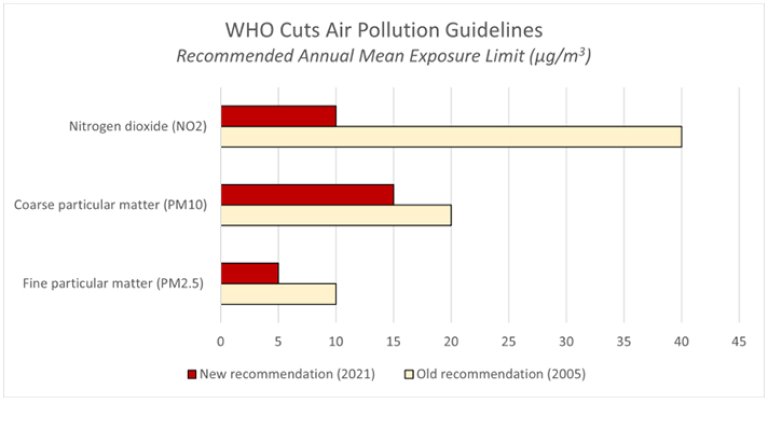The World Health Organization (WHO) cut its recommendation for air pollution levels drastically on September 22nd. For the first time since 2005, the recommended levels have been changed due to updated knowledge on how poor air quality affect human health. The result is a 75% reduction in nitrogen dioxide (NO2), which mainly originates from diesel engines, 25 percent reduction in coarse particulate matter (PM10) which can be dust from various sources like pollen or particles from asphalt and car tires, and a 50% reduction in fine particulate matter (PM2.5) which mainly comes from burning fossil fuels [1]. Particulate matter is measured by a diameter smaller than respectively 10 µm (PM10) and 2.5 µm (PM2.5). For the record: 1 µm equals one millionth of a meter or one thousandth of a millimeter. In comparison, the average diameter of a human hair equals 50-70 µm.
Floating aerosols like PM10 and in particular the tiny PM2.5 is harmful to humans because the particles are absorbed into human bloodstreams and can interfere with organs. Research has shown how this interference causes heart and lung disease, cancer, diabetes and dementia. A recent study estimated that PM2.5 from burning fossil fuels has led to a global total of 8.7 million premature deaths, which represents almost one in five deaths worldwide [2].
Air pollution has led to national and regional government action to enhance climate change mitigation efforts. Lower emissions both improves inhabitants' health and helps nations reach climate targets. In 2019, 90 percent of the global population lived in cities where the air pollution exceeded the old 2005 WHO guidelines for long term exposure to PM2.5. Now that the threshold is cut in half, practically all humans breathe harmful air.
The WHO advises an immediate, concerted action from local, national and regional level policy-makers working in sectors like transport, energy, waste management, urban planning, and agriculture [3]. Policies that enhance clean technologies and energy efficiency in these sectors may lead to increased demand and profits for companies that deliver products and services to support a rapid transition to the low emission society.
Solution themes that can contribute to counter air pollution are Renewable Energy, Smart Cities and Circular Economy. Solution sub-themes of interest for exposure to the most relevant segments are batteries, grids and infrastructure, wind, solar, resource efficiency, sustainable agriculture, energy efficient buildings, public and electric transport and micromobility.

[1] World Health Organization. (2021). WHO global air quality guidelines: particulate matter (PM2.5 and PM10), ozone, nitrogen dioxide, sulfur dioxide and carbon monoxide. World Health Organization. https://apps.who.int/iris/handle/10665/345329. License: CC BY-NC-SA 3.0 IGO
[2] Karn Vohra, Alina Vodonos, Joel Schwartz, Eloise A. Marais, Melissa P. Sulprizio, Loretta J. Mickley, Global mortality from outdoor fine particle pollution generated by fossil fuel combustion: Results from GEOS-Chem, Environmental Research, Volume 195, 2021, 110754, ISSN 0013-9351, https://doi.org/10.1016/j.envres.2021.110754/ https://www.sciencedirect.com/science/article/pii/S0013935121000487
[3] WHO, Ambient (outdoor) air pollution, https://www.who.int/news-room/fact-sheets/detail/ambient-(outdoor)-air-quality-and-health




